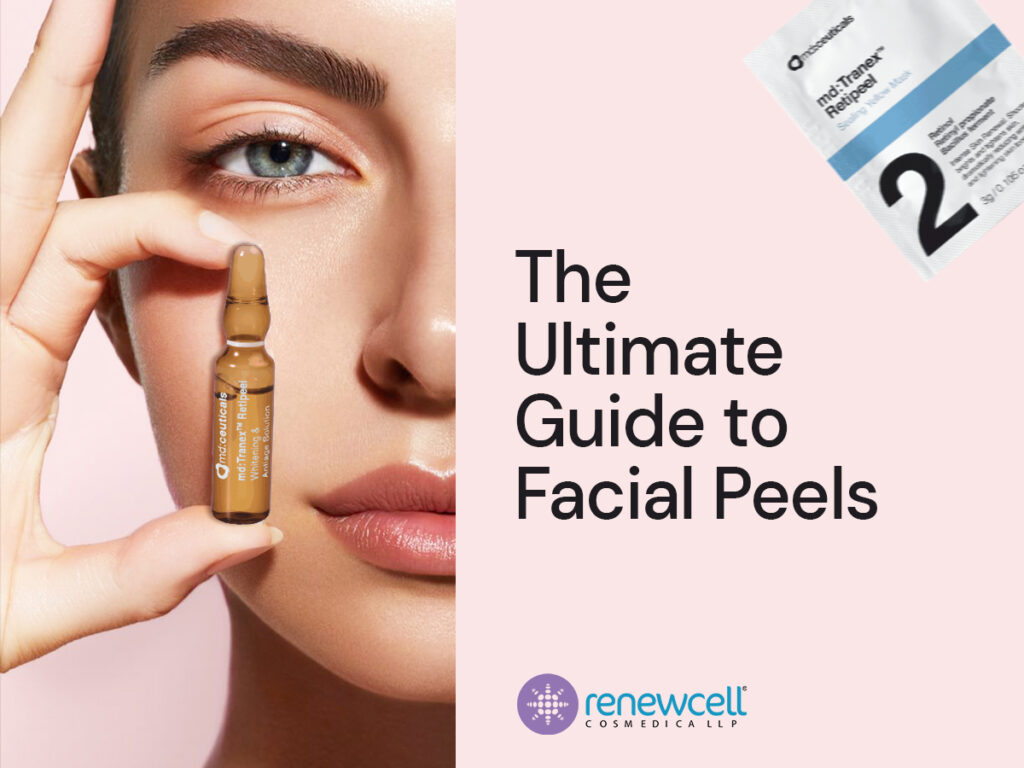Author: Simran Chalke / Date: 29 October 2024
What if the secret to radiant, youthful skin lies just beneath the surface?
Facial peels are a scientifically validated approach to rejuvenating skin, utilizing controlled exfoliation to remove dull, damaged layers and stimulate new cellular growth. In this blog, we’ll explore the science behind chemical peels, how they transform the skin, and why integrating these treatments into your skincare routine could be the catalyst for long-lasting improvements in skin texture, tone, and clarity.
How Facial Peels Work: The Science of Exfoliation
Facial peels, commonly used in dermatology and cosmetic practices, involve the application of a chemical solution to the skin’s surface, leading to the exfoliation of the epidermal layers. This controlled chemical exfoliation triggers a wound-healing response, stimulating the production of new skin cells and collagen, enhancing skin smoothness, reducing pigmentation, and improving elasticity. Depending on the formulation, peels can target a variety of concerns, from surface-level dullness to deeper wrinkles and acne scars.
The active ingredients in chemical peels typically include alpha-hydroxy acids (AHAs), beta-hydroxy acids (BHAs), or trichloroacetic acid (TCA). Each of these acids works at different depths, with varying mechanisms of action. The choice of acid and its concentration determine the depth of the peel: superficial, medium, or deep, each tailored to specific skin concerns and treatment goals.
Not All Peels Are Created Equal: A Scientific Breakdown of Peel Depths
Chemical peels can be classified into three primary categories based on the depth of skin penetration:
Superficial Peels: These target the outermost layer of skin, the stratum corneum, promoting exfoliation with minimal downtime. Commonly formulated with AHAs like glycolic or lactic acid, these peels effectively address minor textural issues, mild acne, and uneven skin tone.
They work by breaking the bonds between corneocytes, accelerating cell turnover and leaving the skin smoother and brighter.
Medium Peels: Penetrating deeper into the epidermis and upper dermis, medium-depth peels use higher concentrations of acids, often combining TCA with AHAs. These peels address more significant concerns like moderate wrinkles, sun damage, and acne scars. By inducing controlled damage to the dermal layers, these peels stimulate collagen synthesis and promote deeper cellular regeneration, resulting in skin rejuvenation.
Deep Peels: The most intensive category, deep peels penetrate into the reticular dermis, affecting both epidermal and dermal layers. Typically involving phenol or high-concentration TCA, these peels are reserved for deep wrinkles, severe hyperpigmentation, and melasma.
Deep peels induce an extensive wound-healing process, promoting the formation of new collagen and elastin fibers, with significant results but longer recovery times.
Mechanism of Action: How Peels Transform the Skin
The efficacy of chemical peels is rooted in their ability to induce controlled damage to the skin, triggering its natural repair mechanisms.
Chemical peels rejuvenate the skin through a series of intricate biological processes. In superficial peels, acids like glycolic acid initiate corneocyte disjunction, breaking down the bonds between keratinocytes in the stratum corneum. This process leads to the exfoliation of dead skin cells, resulting in a smoother, more even texture. For medium and deep peels, controlled damage reaches the dermis, stimulating fibroblasts to produce new collagen fibers, which enhances the skin’s structural integrity and reduces the appearance of fine lines and scars. Additionally, peels can regulate melanin production by affecting melanocytes. While superficial peels fade surface-level hyperpigmentation, deeper peels address conditions like melasma by dispersing excess melanin, leading to clearer, more even-toned skin.
Post-Treatment Healing and Optimal Care
The healing process after a peel is as scientifically significant as the treatment itself. The skin’s ability to regenerate post-peel depends on several biological factors, including inflammation modulation, barrier repair, and cellular regeneration. Immediately following a peel, the epidermal barrier is compromised, making it crucial to avoid UV exposure and maintain moisture balance to prevent transepidermal water loss (TEWL).
Best Practices for Post-Peel Care
Sun Protection: UV exposure after a peel can lead to increased melanin production and post-inflammatory hyperpigmentation. A broad-spectrum SPF 30 or higher is essential to protect the skin from further damage.
Barrier Restoration: Peels disrupt the skin’s barrier function, making it vulnerable to dehydration and irritants. Post-peel care should focus on using ingredients like ceramides, hyaluronic acid, and aloevera to hydrate and soothe the skin.
Avoid Active Ingredients: The use of retinoids, exfoliants, and strong acids should be paused for at least a week post-treatment to prevent irritation and allow the skin’s natural healing process to unfold without disruption.
Conclusion: A Science-Backed Reset for Your Skin
Chemical peels offer a scientifically proven method for skin rejuvenation, utilizing the body’s own healing processes to generate new, healthy skin cells and increase collagen production.
From superficial peels that brighten and refresh to deep peels that provide profound transformation, these treatments have the power to reset your skin and address a wide array of concerns. With the right post-treatment care, your skin will emerge revitalized, glowing, and ready to take on the world. It’s not just about exfoliation; it’s about unlocking the potential hidden beneath the surface, one layer at a time.
Author: Simran Chalke / Date: 29 October 2024

